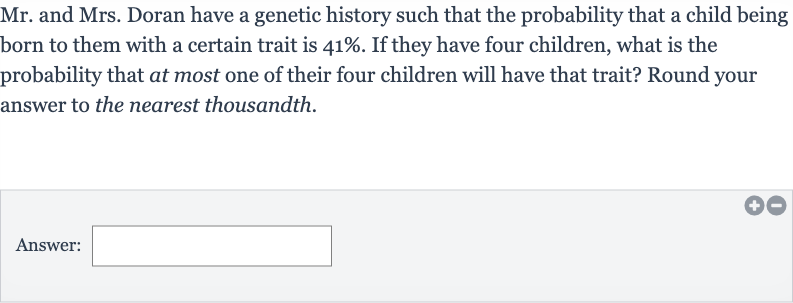AI tutor
Welcome to Bytelearn!
Let’s check out your problem:

Mr. and Mrs. Doran have a genetic history such that the probability that a child being born to them with a certain trait is . If they have four children, what is the probability that at most one of their four children will have that trait? Round your answer to the nearest thousandth.Answer:
Full solution
Q. Mr. and Mrs. Doran have a genetic history such that the probability that a child being born to them with a certain trait is . If they have four children, what is the probability that at most one of their four children will have that trait? Round your answer to the nearest thousandth.Answer:
- Understand and Identify Formula: Understand the problem and identify the binomial probability formula for at most one success. The problem asks for the probability that at most one of the four children will have the genetic trait. This means we need to calculate the probability of having exactly one child with the trait and the probability of having no children with the trait, then add these probabilities together. The binomial probability formula is , where is the number of trials, is the number of successes, and is the probability of success on a single trial.
- Calculate Probability of No Children: Calculate the probability of having no children with the trait . Using the binomial probability formula, we substitute , , and .
- Calculate Value of : Calculate the value of .
- Calculate Probability of One Child: Calculate the probability of having exactly one child with the trait . Using the binomial probability formula, we substitute , , and .
- Calculate Value of : Calculate the value of .
- Multiply Values for P(X = ): Multiply the values together to find .
- Add Probabilities for Total: Add the probabilities of and to find the total probability of at most one child with the trait.
- Round to Nearest Thousandth: Round the answer to the nearest thousandth.P(at most one) =
More problems from Find probabilities using the binomial distribution
QuestionGet tutor help
QuestionGet tutor help
QuestionGet tutor help
QuestionGet tutor help
QuestionGet tutor help
QuestionGet tutor help
QuestionGet tutor help
QuestionGet tutor help
QuestionGet tutor help
QuestionGet tutor help
